Refer to the scenario.
# Introduction to the customer
You are helping a company add Aruba ClearPass to their network, which uses Aruba network infrastructure devices.
The company currently has a Windows domain and Windows CA. The Window CA issues certificates to domain computers, domain users, and servers such as domain controllers. An example of a certificate issued by the Windows CA is shown here.

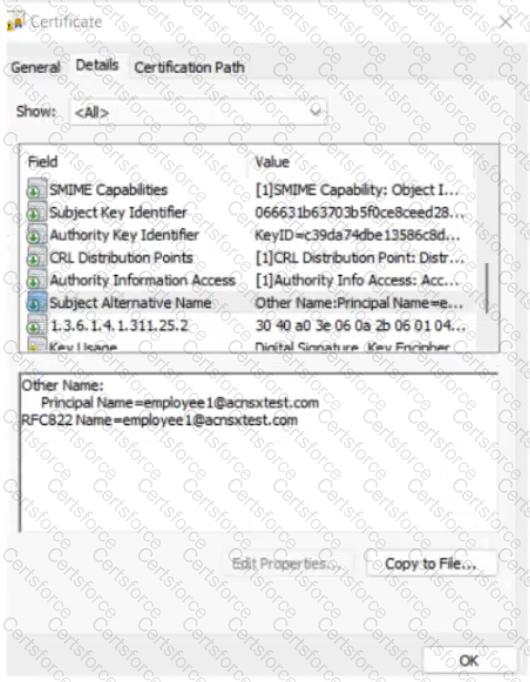
The company is in the process of adding Microsoft Endpoint Manager (Intune) to manage its mobile clients. The customer is maintaining the on-prem AD for now and uses Azure AD Connect to sync with Azure AD.
# Requirements for issuing certificates to mobile clients
The company wants to use ClearPass Onboard to deploy certificates automatically to mobile clients enrolled in Intune. During this process, Onboard should communicate with Azure AD to validate the clients. High availability should also be provided for this scenario; in other words, clients should be able to get certificates from Subscriber 2 if Subscriber 1 is down.
The Intune admins intend to create certificate profiles that include a UPN SAN with the UPN of the user who enrolled the device.
# Requirements for authenticating clients
The customer requires all types of clients to connect and authenticate on the same corporate SSID.
The company wants CPPM to use these authentication methods:
 EAP-TLS to authenticate users on mobile clients registered in Intune
EAP-TLS to authenticate users on mobile clients registered in Intune
 TEAR, with EAP-TLS as the inner method to authenticate Windows domain computers and the users on them
TEAR, with EAP-TLS as the inner method to authenticate Windows domain computers and the users on them
To succeed, EAP-TLS (standalone or as a TEAP method) clients must meet these requirements:
 Their certificate is valid and is not revoked, as validated by OCSP
Their certificate is valid and is not revoked, as validated by OCSP
 The client’s username matches an account in AD
The client’s username matches an account in AD
# Requirements for assigning clients to roles
After authentication, the customer wants the CPPM to assign clients to ClearPass roles based on the following rules:
 Clients with certificates issued by Onboard are assigned the “mobile-onboarded” role
Clients with certificates issued by Onboard are assigned the “mobile-onboarded” role
 Clients that have passed TEAP Method 1 are assigned the “domain-computer” role
Clients that have passed TEAP Method 1 are assigned the “domain-computer” role
 Clients in the AD group “Medical” are assigned the “medical-staff” role
Clients in the AD group “Medical” are assigned the “medical-staff” role
 Clients in the AD group “Reception” are assigned to the “reception-staff” role
Clients in the AD group “Reception” are assigned to the “reception-staff” role
The customer requires CPPM to assign authenticated clients to AOS firewall roles as follows:
 Assign medical staff on mobile-onboarded clients to the “medical-mobile” firewall role
Assign medical staff on mobile-onboarded clients to the “medical-mobile” firewall role
 Assign other mobile-onboarded clients to the “mobile-other” firewall role
Assign other mobile-onboarded clients to the “mobile-other” firewall role
 Assign medical staff on domain computers to the “medical-domain” firewall role
Assign medical staff on domain computers to the “medical-domain” firewall role
 All reception staff on domain computers to the “reception-domain” firewall role
All reception staff on domain computers to the “reception-domain” firewall role
 All domain computers with no valid user logged in to the “computer-only” firewall role
All domain computers with no valid user logged in to the “computer-only” firewall role
 Deny other clients access
Deny other clients access
# Other requirements
Communications between ClearPass servers and on-prem AD domain controllers must be encrypted.
# Network topology
For the network infrastructure, this customer has Aruba APs and Aruba gateways, which are managed by Central. APs use tunneled WLANs, which tunnel traffic to the gateway cluster. The customer also has AOS-CX switches that are not managed by Central at this point.
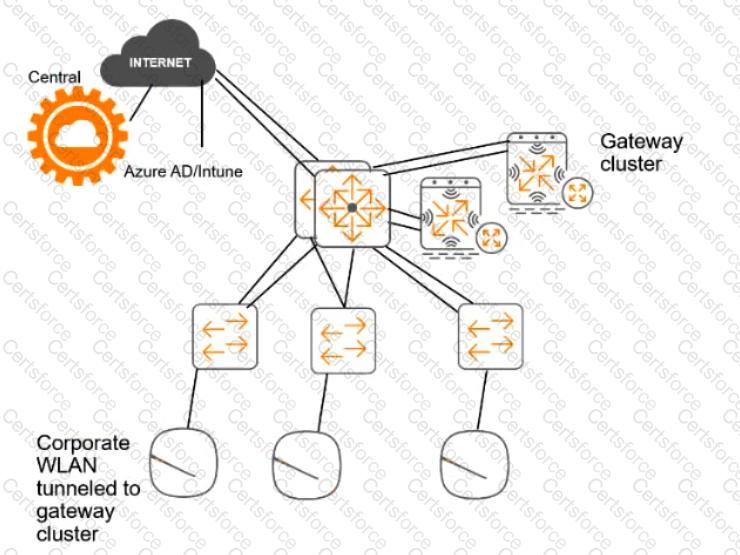
# ClearPass cluster IP addressing and hostnames
A customer’s ClearPass cluster has these IP addresses:
 Publisher = 10.47.47.5
Publisher = 10.47.47.5
 Subscriber 1 = 10.47.47.6
Subscriber 1 = 10.47.47.6
 Subscriber 2 = 10.47.47.7
Subscriber 2 = 10.47.47.7
 Virtual IP with Subscriber 1 and Subscriber 2 = 10.47.47.8
Virtual IP with Subscriber 1 and Subscriber 2 = 10.47.47.8
The customer’s DNS server has these entries
 cp.acnsxtest.com = 10.47.47.5
cp.acnsxtest.com = 10.47.47.5
 cps1.acnsxtest.com = 10.47.47.6
cps1.acnsxtest.com = 10.47.47.6
 cps2.acnsxtest.com = 10.47.47.7
cps2.acnsxtest.com = 10.47.47.7
 radius.acnsxtest.com = 10.47.47.8
radius.acnsxtest.com = 10.47.47.8
 onboard.acnsxtest.com = 10.47.47.8
onboard.acnsxtest.com = 10.47.47.8
You cannot see flow attributes for wireless clients.
What should you check?
Refer to the scenario.
# Introduction to the customer
You are helping a company add Aruba ClearPass to their network, which uses Aruba network infrastructure devices.
The company currently has a Windows domain and Windows CA. The Window CA issues certificates to domain computers, domain users, and servers such as domain controllers. An example of a certificate issued by the Windows CA is shown here.

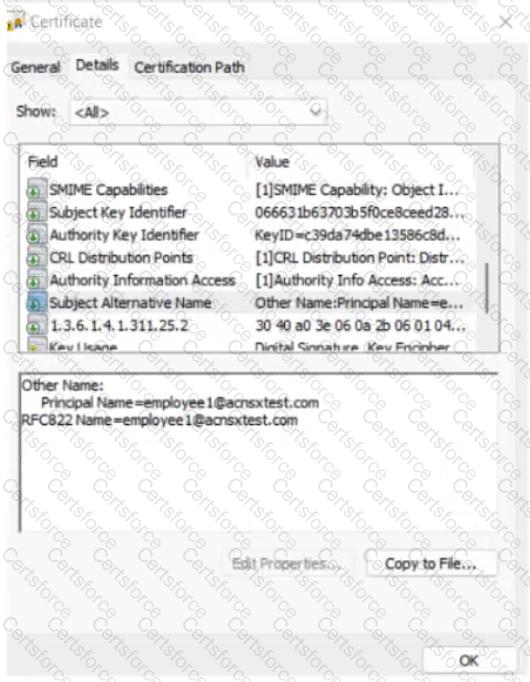
The company is in the process of adding Microsoft Endpoint Manager (Intune) to manage its mobile clients. The customer is maintaining the on-prem AD for now and uses Azure AD Connect to sync with Azure AD.
# Requirements for issuing certificates to mobile clients
The company wants to use ClearPass Onboard to deploy certificates automatically to mobile clients enrolled in Intune. During this process, Onboard should communicate with Azure AD to validate the clients. High availability should also be provided for this scenario; in other words, clients should be able to get certificates from Subscriber 2 if Subscriber 1 is down.
The Intune admins intend to create certificate profiles that include a UPN SAN with the UPN of the user who enrolled the device.
# Requirements for authenticating clients
The customer requires all types of clients to connect and authenticate on the same corporate SSID.
The company wants CPPM to use these authentication methods:
 EAP-TLS to authenticate users on mobile clients registered in Intune
EAP-TLS to authenticate users on mobile clients registered in Intune
 TEAR, with EAP-TLS as the inner method to authenticate Windows domain computers and the users on them
TEAR, with EAP-TLS as the inner method to authenticate Windows domain computers and the users on them
To succeed, EAP-TLS (standalone or as a TEAP method) clients must meet these requirements:
 Their certificate is valid and is not revoked, as validated by OCSP
Their certificate is valid and is not revoked, as validated by OCSP
 The client’s username matches an account in AD
The client’s username matches an account in AD
# Requirements for assigning clients to roles
After authentication, the customer wants the CPPM to assign clients to ClearPass roles based on the following rules:
 Clients with certificates issued by Onboard are assigned the “mobile-onboarded” role
Clients with certificates issued by Onboard are assigned the “mobile-onboarded” role
 Clients that have passed TEAP Method 1 are assigned the “domain-computer” role
Clients that have passed TEAP Method 1 are assigned the “domain-computer” role
 Clients in the AD group “Medical” are assigned the “medical-staff” role
Clients in the AD group “Medical” are assigned the “medical-staff” role
 Clients in the AD group “Reception” are assigned to the “reception-staff” role
Clients in the AD group “Reception” are assigned to the “reception-staff” role
The customer requires CPPM to assign authenticated clients to AOS firewall roles as follows:
 Assign medical staff on mobile-onboarded clients to the “medical-mobile” firewall role
Assign medical staff on mobile-onboarded clients to the “medical-mobile” firewall role
 Assign other mobile-onboarded clients to the “mobile-other” firewall role
Assign other mobile-onboarded clients to the “mobile-other” firewall role
 Assign medical staff on domain computers to the “medical-domain” firewall role
Assign medical staff on domain computers to the “medical-domain” firewall role
 All reception staff on domain computers to the “reception-domain” firewall role
All reception staff on domain computers to the “reception-domain” firewall role
 All domain computers with no valid user logged in to the “computer-only” firewall role
All domain computers with no valid user logged in to the “computer-only” firewall role
 Deny other clients access
Deny other clients access
# Other requirements
Communications between ClearPass servers and on-prem AD domain controllers must be encrypted.
# Network topology
For the network infrastructure, this customer has Aruba APs and Aruba gateways, which are managed by Central. APs use tunneled WLANs, which tunnel traffic to the gateway cluster. The customer also has AOS-CX switches that are not managed by Central at this point.

# ClearPass cluster IP addressing and hostnames
A customer’s ClearPass cluster has these IP addresses:
 Publisher = 10.47.47.5
Publisher = 10.47.47.5
 Subscriber 1 = 10.47.47.6
Subscriber 1 = 10.47.47.6
 Subscriber 2 = 10.47.47.7
Subscriber 2 = 10.47.47.7
 Virtual IP with Subscriber 1 and Subscriber 2 = 10.47.47.8
Virtual IP with Subscriber 1 and Subscriber 2 = 10.47.47.8
The customer’s DNS server has these entries
 cp.acnsxtest.com = 10.47.47.5
cp.acnsxtest.com = 10.47.47.5
 cps1.acnsxtest.com = 10.47.47.6
cps1.acnsxtest.com = 10.47.47.6
 cps2.acnsxtest.com = 10.47.47.7
cps2.acnsxtest.com = 10.47.47.7
 radius.acnsxtest.com = 10.47.47.8
radius.acnsxtest.com = 10.47.47.8
 onboard.acnsxtest.com = 10.47.47.8
onboard.acnsxtest.com = 10.47.47.8
You have imported the root certificate for the Windows CA to the ClearPass CA Trust list.
Which usages should you add to it based on the scenario requirements?
What is a common characteristic of a beacon between a compromised device and a command and control server?
Refer to the scenario.
A customer has an AOS10 architecture that is managed by Aruba Central. Aruba infrastructure devices authenticate clients to an Aruba ClearPass cluster.
In Aruba Central, you are examining network traffic flows on a wireless IoT device that is categorized as “Raspberry Pi” clients. You see SSH traffic. You then check several more wireless IoT clients and see that they are sending SSH also.
You want an easy way to communicate the information that an IoT client has used SSH to Aruba ClearPass Policy Manager (CPPM).
What step should you take?
Refer to the scenario.
# Introduction to the customer
You are helping a company add Aruba ClearPass to their network, which uses Aruba network infrastructure devices.
The company currently has a Windows domain and Windows CA. The Window CA issues certificates to domain computers, domain users, and servers such as domain controllers. An example of a certificate issued by the Windows CA is shown here.
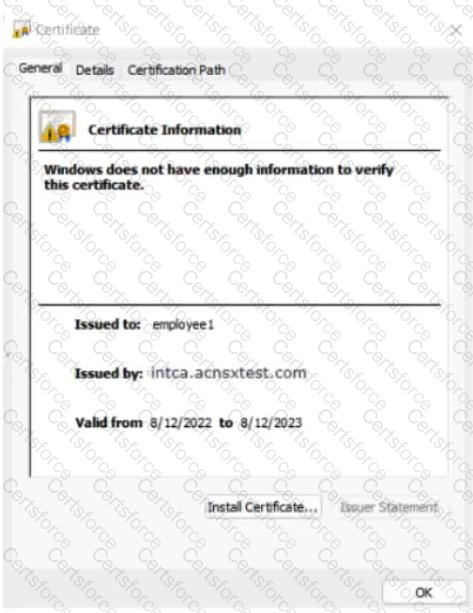

The company is in the process of adding Microsoft Endpoint Manager (Intune) to manage its mobile clients. The customer is maintaining the on-prem AD for now and uses Azure AD Connect to sync with Azure AD.
# Requirements for issuing certificates to mobile clients
The company wants to use ClearPass Onboard to deploy certificates automatically to mobile clients enrolled in Intune. During this process, Onboard should communicate with Azure AD to validate the clients. High availability should also be provided for this scenario; in other words, clients should be able to get certificates from Subscriber 2 if Subscriber 1 is down.
The Intune admins intend to create certificate profiles that include a UPN SAN with the UPN of the user who enrolled the device.
# Requirements for authenticating clients
The customer requires all types of clients to connect and authenticate on the same corporate SSID.
The company wants CPPM to use these authentication methods:
 EAP-TLS to authenticate users on mobile clients registered in Intune
EAP-TLS to authenticate users on mobile clients registered in Intune
 TEAR, with EAP-TLS as the inner method to authenticate Windows domain computers and the users on them
TEAR, with EAP-TLS as the inner method to authenticate Windows domain computers and the users on them
To succeed, EAP-TLS (standalone or as a TEAP method) clients must meet these requirements:
 Their certificate is valid and is not revoked, as validated by OCSP
Their certificate is valid and is not revoked, as validated by OCSP
 The client’s username matches an account in AD
The client’s username matches an account in AD
# Requirements for assigning clients to roles
After authentication, the customer wants the CPPM to assign clients to ClearPass roles based on the following rules:
 Clients with certificates issued by Onboard are assigned the “mobile-onboarded” role
Clients with certificates issued by Onboard are assigned the “mobile-onboarded” role
 Clients that have passed TEAP Method 1 are assigned the “domain-computer” role
Clients that have passed TEAP Method 1 are assigned the “domain-computer” role
 Clients in the AD group “Medical” are assigned the “medical-staff” role
Clients in the AD group “Medical” are assigned the “medical-staff” role
 Clients in the AD group “Reception” are assigned to the “reception-staff” role
Clients in the AD group “Reception” are assigned to the “reception-staff” role
The customer requires CPPM to assign authenticated clients to AOS firewall roles as follows:
 Assign medical staff on mobile-onboarded clients to the “medical-mobile” firewall role
Assign medical staff on mobile-onboarded clients to the “medical-mobile” firewall role
 Assign other mobile-onboarded clients to the “mobile-other” firewall role
Assign other mobile-onboarded clients to the “mobile-other” firewall role
 Assign medical staff on domain computers to the “medical-domain” firewall role
Assign medical staff on domain computers to the “medical-domain” firewall role
 All reception staff on domain computers to the “reception-domain” firewall role
All reception staff on domain computers to the “reception-domain” firewall role
 All domain computers with no valid user logged in to the “computer-only” firewall role
All domain computers with no valid user logged in to the “computer-only” firewall role
 Deny other clients access
Deny other clients access
# Other requirements
Communications between ClearPass servers and on-prem AD domain controllers must be encrypted.
# Network topology
For the network infrastructure, this customer has Aruba APs and Aruba gateways, which are managed by Central. APs use tunneled WLANs, which tunnel traffic to the gateway cluster. The customer also has AOS-CX switches that are not managed by Central at this point.
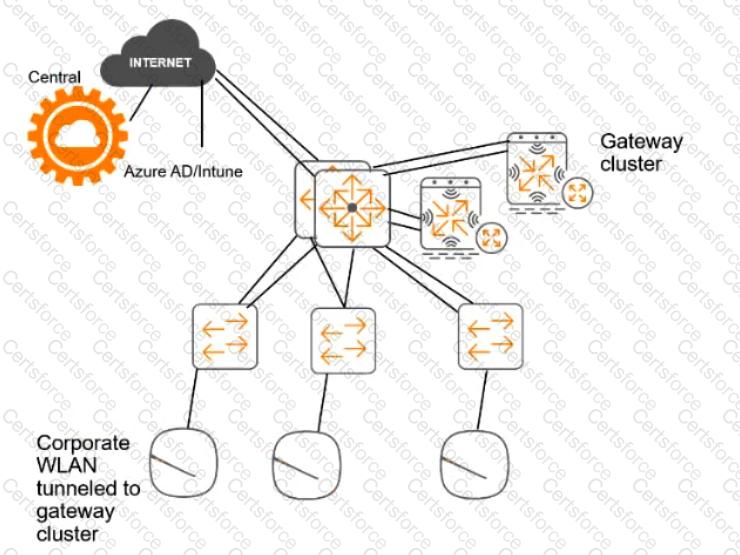
# ClearPass cluster IP addressing and hostnames
A customer’s ClearPass cluster has these IP addresses:
 Publisher = 10.47.47.5
Publisher = 10.47.47.5
 Subscriber 1 = 10.47.47.6
Subscriber 1 = 10.47.47.6
 Subscriber 2 = 10.47.47.7
Subscriber 2 = 10.47.47.7
 Virtual IP with Subscriber 1 and Subscriber 2 = 10.47.47.8
Virtual IP with Subscriber 1 and Subscriber 2 = 10.47.47.8
The customer’s DNS server has these entries
 cp.acnsxtest.com = 10.47.47.5
cp.acnsxtest.com = 10.47.47.5
 cps1.acnsxtest.com = 10.47.47.6
cps1.acnsxtest.com = 10.47.47.6
 cps2.acnsxtest.com = 10.47.47.7
cps2.acnsxtest.com = 10.47.47.7
 radius.acnsxtest.com = 10.47.47.8
radius.acnsxtest.com = 10.47.47.8
 onboard.acnsxtest.com = 10.47.47.8
onboard.acnsxtest.com = 10.47.47.8
The customer needs a secure way for users to enroll their new wireless clients in Intune. You are recommending a new WLAN that will provide the users with limited access for the enrollment.
You have set up captive portal for clients on this WLAN to a web page with instructions for enrolling devices. You will need to add several hostnames to the captive portal allowlist manually.
What is one of those hostnames?
A customer has an AOS 10-based mobility solution, which authenticates clients to Aruba ClearPass Policy Manager (CPPM). The customer has some wireless devices that support WPA2 in personal mode only.
How can you meet these devices’ needs but improve security?
You need to install a certificate on a standalone Aruba Mobility Controller (MC). The MC will need to use the certificate for the Web UI and for implementing RadSec with Aruba ClearPass Policy Manager. You have been given a certificate with these settings:
 Subject: CN=mc41.site94.example.com
Subject: CN=mc41.site94.example.com
 No SANs
No SANs
 Issuer: CN=ca41.example.com
Issuer: CN=ca41.example.com
 EKUs: Server Authentication, Client Authentication
EKUs: Server Authentication, Client Authentication
What issue does this certificate have for the purposes for which the certificate is intended?
Refer to the scenario.
A customer is migrating from on-prem AD to Azure AD as its sole domain solution. The customer also manages both wired and wireless devices with Microsoft Endpoint Manager (Intune).
The customer wants to improve security for the network edge. You are helping the customer design a ClearPass deployment for this purpose. Aruba network devices will authenticate wireless and wired clients to an Aruba ClearPass Policy Manager (CPPM) cluster (which uses version 6.10).
The customer has several requirements for authentication. The clients should only pass EAP-TLS authentication if a query to Azure AD shows that they have accounts in Azure AD. To further refine the clients’ privileges, ClearPass also should use information collected by Intune to make access control decisions.
You are planning to use Azure AD as the authentication source in 802.1X services.
What should you make sure that the customer understands is required?